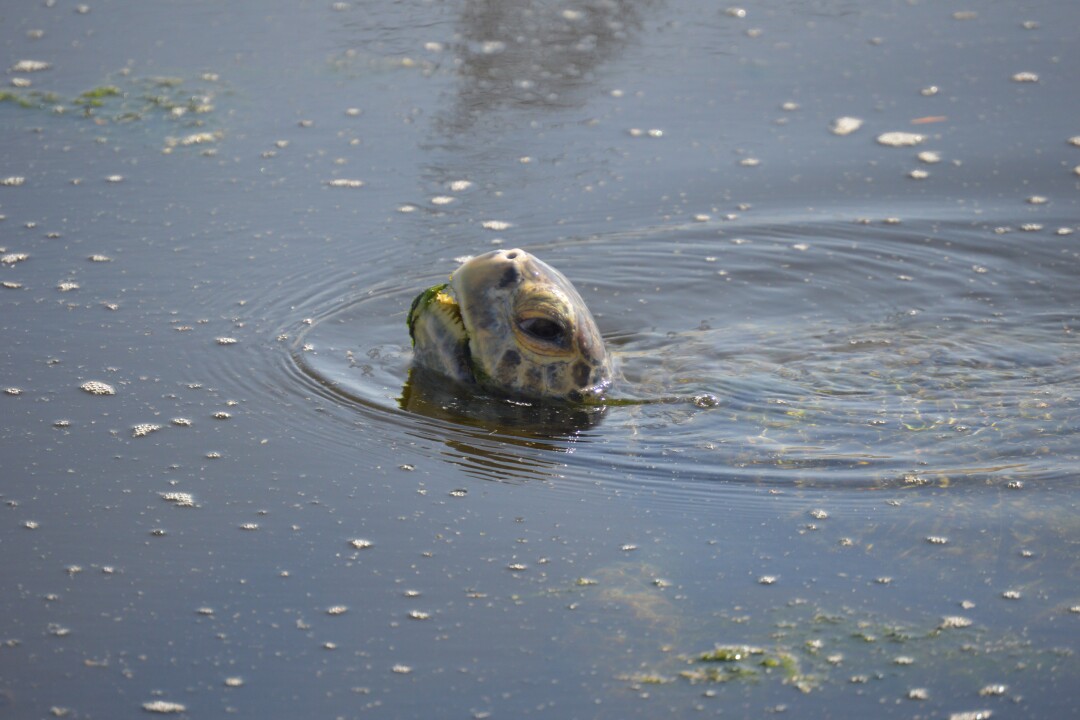Truth matters. Community matters. Your support makes both possible. LAist is one of the few places where news remains independent and free from political and corporate influence. Stand up for truth and for LAist. Make your year-end tax-deductible gift now.
Gliding through just a few feet of murky water, a green sea turtle dodges beer cans, plastic bags and shopping carts in the concrete-lined San Gabriel River.
A scene that feels very turtle out of water.

Here's this animal that we most often see in photos of people snorkeling during a tropical vacation. It's munching on algae in fetid suburban runoff, with cars zipping by on the 605 Freeway a few hundred yards away.
Seeing any nature thrive here is a remarkable sight in and of itself. But the turtle's presence is even more awe-inspiring when you think about the epic journey it likely went through to get here.
Beating the odds
Odds are, the turtle barely made it off some beach 1,000-plus miles away, then managed to navigate the ocean for years, avoiding predation, fishermen who might accidentally catch it and speeding boats that might strike it — all to end up next to mattresses in a river just south of L.A.


Once on the path to extinction, these East Pacific green sea turtles are making such a strong comeback that they’re now taking up residence in the San Gabriel River in large numbers, far beyond their typical spots in places like Baja, California and the southern San Diego Bay.
“I think it's only recently that we've really realized that green sea turtles are coming this far up the river,” said Tina Fahy, West Coast Sea Turtle Recovery Coordinator with the National Oceanic and Atmospheric Administration (NOAA).
She, along with Justin Greenman, who leads efforts to save stranded animals, took me to a spot in the river where the vegetation ends and the vast expanse of the San Gabriel’s bare concrete begins. We had to make sure that we got there during high tide, because the turtles use the rising water to make it farther up the river channel.
“We didn't really know until we started having some stranded high and dry turtles ... and people thought that they were in trouble,” Fahy said. “They can survive without being in water constantly.”
While these turtles have long been documented hanging out in the warm effluent of power plants downstream, swimming through the Los Cerritos wetlands and at nearby Seal Beach, their presence farther upstream is one of the signs they're on the move as their populations boom and waters continue to warm.
“Whereas 20 years ago, we had very few numbers of turtles in our local waters, now we're seeing turtles in nooks and crannies, in areas that we've never seen them before,” said Jeffrey Seminoff, who leads the Marine Turtle Ecology and Assessment Program at NOAA’s Southwest Fisheries Science Center.
"It's really only been in about the last decade that we've seen such a large number of animals," he said. "I believe the San Gabriel River is the most dense green turtle population that we have here in Southern California."
A harrowing journey to and from L.A.
Green sea turtles can be found all around the world, but there are distinct populations. Ours are known as Eastern Pacific green sea turtles.
Nesting season begins in October, but the turtles don’t lay their eggs here in L.A. They leave the confines of the San Gabriel, head out into the open ocean and slowly swim more than 1,000 miles south to warm beaches like Playa Colola in Michoacán, Mexico.
The turtles mate offshore and the females head in to the beach to bury their eggs in the sand.
Emaciated and exhausted, they then turn around and limp back up to their homes all across Baja and Southern California. The journey is so harrowing that it can take a few years for a female to recover before she’s ready to lay eggs again.
After about 55 days, their babies emerge and steadily get picked off by predators like birds, crabs and raccoons along the beaches. The survivors make their way into the open ocean where they’ll spend the next four years or so passively floating. With yet more predators prowling the seas, the best estimate is that only about 1% of them make it to adulthood.
Around age 6, the turtles swim inland and settle in coastal habitats like the San Gabriel River for the next 15 years. There, they can forage and grow until they're full-fledged adults ready to follow the Earth’s magnetic field back down south to mate and lay eggs, like their parents before them.
The best estimates say that they can live longer than 80 years and grow to over 400 pounds.
The ones observed in the San Gabriel River seem to be adolescents.
We almost lost the turtles
About 50 years ago, green sea turtle populations, including those in the Eastern Pacific, absolutely cratered.
Habitat loss, ship strikes and being accidentally caught by fishermen all jeopardized their survival, as did the fact that they were being hunted for their meat and eggs in Mexico.
They were put on the U.S. federal endangered species list in the 1970s. And by the 1990s, Mexico had taken steps to both protect nesting sites and foraging populations, and ban the sale and use of turtle products.
Since then, the turtles have been steadily recovering.
Back in the 1980s, roughly 250 turtles were spotted on Playa Colola in Michoacán over the six-month-long nesting season. In 2015, more than 1,000 were spotted in one night, Seminoff said.
In April 2016, their status was changed from endangered to threatened, and over the past five years their populations here have exploded.

Now, they're showing up in surprising numbers, farther up the San Gabriel River than was previously observed.
“Part of why I think we're seeing turtles in these different habitats where we've never seen them before, is simply a function of crowding,” said Seminoff. “There are sites like the San Gabriel River, for example, where we might be at what we call ‘capacity.’ There's just so many turtles that there's a limitation of food. And if that's happening more and more in different spots throughout Southern California, that's going to force turtles to find new spots that have abundant food supplies so that they can set up shop and live there for years at a time.”
Why do the turtles like the San Gabriel River?
When it comes to comfort, turtles are looking for warm water, food and safety, and the San Gabriel River seems to meet those requirements.
All the bridge pilings may be a great place for them to rest, as they can protect the turtles from getting jostled around by the tides.
There are plenty of rock piles for algae to grow and mud for invertebrates to flourish in, both of which are critical sources of food.
Boat strikes and getting accidentally caught aren't a concern because the river is protected.

On top of all that, its waters are being warmed by the effluent from power plants downstream. Moving upstream, giant concrete walls absorb the sun’s energy during the day and radiate it out at night, likely keeping resulting in temperatures a bit more habitable for reptiles that prefer tropical and subtropical locations.
Speaking of which, as waters warm due to climate change, habitats farther to the north will likely open up as well.
“I expect that we'll see turtles move farther and farther north along the coast of California," Seminoff said. "We're seeing green turtles in places like Monterey Bay with greater frequency these days. It's not normal by any sense of the word."
In July, the National Marine Fisheries Service and NOAA proposed designating turtle hotspots across Southern California, marine-critical habitats, which would afford the turtles additional protections. Essentially, the designation is meant to mitigate impacts on the turtles from activities like construction, and requires federal agencies consult with NOAA during the process.
It's truly a period of discovery, and there are a ton of questions that NOAA and others want to answer about turtle habits and movement, particularly in the San Gabriel River.
That’s where you come in.
Scientists need your help studying them
For the past decade or so, scientists have been actively gathering information about turtles in the lower part of the river, but are looking to expand their studies farther upstream given the population boom.
If you’d like to volunteer to help, The Aquarium of the Pacific has been running a turtle spotting program since 2012. Participants get together every first Saturday of the month and spend about 30 minutes out in the field counting turtles. The data they gather is made available to NOAA and the Los Cerritos Wetlands authority, in an effort to track turtle activity.
If you want to go out on your own and provide information about turtles directly to NOAA, you can head to the spot on the map above, and submit whatever you gather here.
Help With Turtle Monitoring
- Volunteer for the Sea Turtle Monitoring Project
- Gather observations on your own and send them into NOAA
- Observe the turtles responsibly. Stay on the bike trail, and bring binoculars to observe from a distance
Make sure to include a picture of the turtle if possible, as each has a unique set of markings on its head, which can help scientists better track turtle movement over time.
Oh, and if you see a turtle stranded, call NOAA's California stranding network hotline at (562) 506-4315.


















